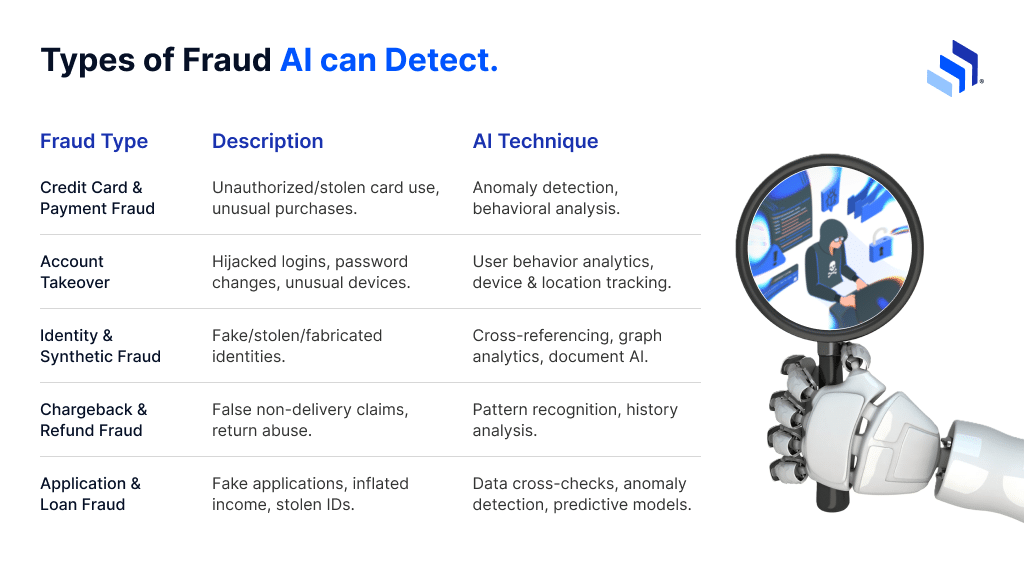
AI Fraud Detection in 2025: How Businesses Can Prevent Threats with Smarter Strategies
Manu Jain | August 30, 2025 , 11 min read
Table Of Content
Fraudsters are getting smarter. Their attacks are more sophisticated now. But AI fraud detection has evolved too, helping businesses move from playing defense to anticipating threats and predicting a criminal’s next move before they even think about it. As a business, you need AI fraud detection to outsmart fraudsters at their own game. But what is AI-powered fraud detection, and what are the benefits? This blog finds answers to these questions.
Key Takeaways
- AI fraud detection learns your customers’ normal behavior patterns to enable it to flag anything suspicious.
- The technology, though expensive upfront, pays for itself by preventing major fraud losses.
- Across millions of transactions, AI is able to spot abnormal patterns, and connect seemingly unrelated suspicious activities as criminals evolve their methods.
- Though effective, you need clean, organized customer data and a 3-6 month learning period for the AI to calibrate properly to your business.
- Challenges like data privacy concerns and explaining AI decisions to customers exist, but the alternative is losing the fraud prevention arms race to increasingly sophisticated criminals.
Understanding AI-Powered Fraud Detection
When a criminal tries to use a stolen credit card to buy expensive electronics, and the transaction is flagged as suspicious and gets blocked, that’s AI in fraud detection.
Fraud detection in AI is not trained to rely on a “flag all purchases over $500” script or set of rules. AI fraud detection solutions rather independently learns what normal behavior looks like for each individual user and acts when a transaction seems suspicious.
To explain this better, your typical Tuesday might involve buying coffee at 8 AM, lunch at noon, and groceries after work. The AI remembers this pattern. When someone suddenly tries to buy a luxury watch in another state at midnight with your card, red flags go up immediately.
The traditional fraud detection systems of today work like security guards checking IDs at the door. AI fraud detection is different by working more like a behavioral psychologist. It notices subtle changes such as your typing speed, or maybe account access from an unusual device.
Machine learning algorithms digest historical fraud data, legitimate transactions, and everything in between. They are able to find and match connections humans would normally miss. A fraudster using a specific combination of browser settings, IP address patterns, and purchase timing might slip past rule-based systems. AI on the other hand would catch these.
The technology analyzes hundreds of variables simultaneously such as time stamps, location data, device information, purchasing patterns, and even how you move your mouse across the screen. Each data point becomes part of a larger picture.
But just as fraudsters get smarter, AI fraud detection too doesn’t react or rely solely on known fraud patterns. It predicts new ones. As criminals develop fresh tactics, the AI adapts and learns too.
Why Businesses Should Choose AI for Fraud Prevention
The advantages of fraud detection using ai are enormous, especially for high risk merchants. Here are compelling reasons why your business needs AI fraud detection solutions.
1. Catch and Prevent Fraud Faster
Human analysts need hours to investigate suspicious transactions. AI needs just milliseconds. While fraudsters are trying to complete their scheme, AI has already blocked the attempt and sent alerts. This speed helps in catching fraud instead of watching your money disappear.
2. AI Learns Continuously
Your fraud team needs sleep, Training, Time off, and many other constraints. AI doesn’t. It processes millions of transactions while your analysts are home having dinner. Every rejected fraud attempt teaches the system something new. Every legitimate transaction refines its understanding. By morning, your AI fraud detection has evolved.
3. AI is Cheaper in terms of Cost
A dedicated fraud analyst costs roughly $65,000 annually. Add benefits, training, and overhead, and you’re looking at $85,000 per person. AI fraud detection handles the workload of multiple analysts for a fraction of that cost. More importantly, it prevents losses that dwarf any implementation expense. One prevented large-scale fraud attack pays for the system multiple times over.
4. Accuracy That Builds Trust
False positives annoy legitimate customers. If they experience too many declined transactions, they’ll find another business. AI reduces these mistakes by understanding individual customer behavior patterns. Your regular customers will experience smoother transactions while actual fraudsters find it very difficult to carry out a transaction.
Types of Fraud AI Can Detect

Modern fraud detection technology, and we are talking about AI here, doesn’t just catch one type of criminal. It’s able to detect all types of fraud and scams.
1. Credit Card and Payment Fraud
Stolen card numbers, skimmed data, compromised payment information, etc are detectable with AI. The technology knows you don’t typically buy three televisions at 4 AM from different states. The system flags these transactions and prevents financial losses.
2. Account Takeover Attacks
If someone hijacks your customer’s login credentials and starts changing passwords, updating contact information, or draining accounts, the AI fraud detection technology notices these behavioral changes immediately. Different login locations, unusual devices, or changes to account settings trigger alerts.
3. Identity Theft and Synthetic Fraud
A real person with fake documents, or a fake person with real documents, or the worst combination: completely fabricated identities built from stolen data fragments are still detectable and prevented with AI. Fraud detection technology cross-references thousands of data points to spot these identities before they can open accounts or make purchases.
4. Chargeback and Refund Fraud
Customers who buy products, claim they never received them, then demand refunds while keeping the merchandise. Or professional scammers who exploit return policies systematically are also in the list. These AI fraud detection types track patterns across customer histories, identifying repeat offenders and suspicious refund requests.
5. Application and Loan Fraud
Fake loan applications with inflated incomes, fabricated employment history, or stolen identities are all verified by AI across multiple databases simultaneously, catching inconsistencies in real-time. It is able to detect that the same person applied for multiple loans under different names or that an application data doesn’t match historical patterns.
Benefits of AI Fraud Detection
The payoff from AI fraud detection are below:
1. Scales Without Breaking
When your business grows and transaction volume increases, fraud attempts multiply. Human fraud teams will hit capacity limits. AI, however, will scale effortlessly. Whether you’re processing a thousand transactions or a million, the system maintains the same speed and accuracy. You won’t experience hiring delays, or experience training periods, nor would performance drop during peak seasons.
2. Better Customer Experience
Fast, accurate fraud detection means smooth transactions for legitimate customers. They won’t experience embarrassing card declines or lengthy verification processes for routine purchases. Customers enjoy seamless experiences while criminals hit impenetrable walls.
3. Complete Coverage
AI never calls in sick, takes vacation, or works banker’s hours. Round-the-clock protection means fraudsters can’t exploit off-hours vulnerabilities. Weekend attacks, holiday schemes, and middle-of-the-night attempts all get the same level of scrutiny.
Challenges of AI Fraud Detection
AI fraud detection isn’t all sunshine and blocked transactions. Challenges exist that businesses need to understand before diving in.
1. Data Privacy
Machine learning fraud detection devours customer data such as purchase histories, location tracking, behavioral patterns, device fingerprints, etc. The more data, the better the protection. But the problem is that customers are getting pickier about privacy.
Businesses are in a tight corner between gathering enough information for effective fraud detection and respecting customer privacy rights. If you get it wrong, regulatory fines can exceed the fraud losses you were trying to prevent.
2. Fraudsters Who Learn Faster
Criminals adapt. They study AI detection patterns, experiment with new attack methods, and share successful tactics across dark web communities. When machine learning fraud detection blocks one approach, fraudsters pivot to another. It’s an arms race where the bad guys sometimes get ahead.
The challenge intensifies because fraudsters can test attacks in real-time, by learning from each blocked attempt. They develop increasingly sophisticated methods to mimic legitimate customer behavior, thus making detection exponentially harder.
3. The Black Box Problem
AI makes thousands of decisions daily, but explaining those decisions becomes nearly impossible. When the system flags a transaction as fraudulent, can you clearly explain why to a customer? Regulatory bodies? Internal auditors?
Machine learning models operate through complex mathematical relationships that even data scientists struggle to interpret. This opacity creates compliance and customer service headaches when legitimate transactions get blocked without clear justification.
4. Implementation Complexity
Setting up effective AI fraud detection isn’t plug-and-play. It requires clean data and proper integration with existing systems. Many businesses underestimate the technical expertise needed for successful deployment.
Training periods can stretch for months while the system learns normal patterns. During this time, protection levels may decrease as algorithms adjust to your environment.
Building an AI Fraud Detection Strategy
Success with AI for fraud detection has nothing to do with buying the fanciest technology but building a strategy that works for your business reality.
1. Start With Your Data Foundation
Your AI is only as good as the data you feed it. Garbage in, garbage out applies here more than anywhere else. Before shopping for AI solutions, audit your current data collection. Transaction records, customer behavior patterns, historical fraud cases, etc. needs to be clean, organized, and accessible.
2. Choose Your Battles Wisely
Not every fraud type deserves equal attention. Analyze your actual losses over the past two years. Where does the money disappear? Credit card fraud might grab headlines, but maybe account takeover attacks cost you more. Focus your AI strategy on the fraud types that hurt your bottom line.
3. Integration Planning That Works
Your new AI system needs to play nice with existing infrastructure such as customer relationship management systems, payment processors, accounting software, etc. Everything must connect seamlessly.
Roll fraud detection gradually across different business segments to reduce risk and allow for course corrections. Start with your highest-risk transactions, prove the system works, then expand coverage.
4. Set Realistic Expectations
AI fraud detection improves over time, not overnight. Initial performance might disappoint as algorithms learn your customer base and fraud patterns. Budget for a learning period of 3-6 months where the system calibrates itself.
Define success metrics upfront. Reduced fraud losses matter, but so do customer satisfaction scores and false positive rates. Balanced scorecards prevent tunnel vision.
5. Build Your Response Playbook
Detecting fraud is only half the battle. What happens when AI flags a suspicious transaction? Who gets notified? How quickly do you investigate? What communication goes to affected customers?
Develop clear escalation procedures and response protocols before your first fraud alert arrives. Nothing undermines fraud detection faster than great detection paired with terrible response processes.
Conclusion
Fraudsters aren’t taking breaks; they’re getting smarter every day. Your fraud prevention strategy can either evolve with AI or fall behind and pay the price in losses. You can’t afford to stay vulnerable. Contact us today to build your AI fraud detection strategy.
Frequently Asked Questions
Q: Can small businesses afford AI-based fraud detection tools?
Yes because cloud-based solutions start under $500 monthly. One prevented fraud attack typically saves more than a year’s subscription cost. Many providers scale pricing with transaction volume, so you only pay as you grow.
Q: How quickly can AI detect fraudulent activity?
AI processes transactions as they happen, flagging suspicious activity before fraudsters can complete their schemes. Traditional detection takes hours or days. AI works at the speed of actual crime.
Q: Is AI fraud detection effective against new and emerging fraud tactics?
Yes, because it learns constantly. Every attack teaches the system something new. Fraudsters develop fresh tactics; AI develops fresh defenses even faster.
Q: What industries benefit most from AI-driven fraud prevention?
Banking, e-commerce, insurance, and healthcare see massive returns. However, any business processing payments or storing customer data benefits. If you handle money or personal information, fraudsters want to steal from you. AI stops them.
Q: How does AI fraud detection differ from traditional fraud detection methods?
Traditional systems follow rules. AI learns patterns. Rules catch known fraud types; AI predicts unknown ones. Traditional methods react after losses happen. AI prevents losses before they occur.
Related Blogs

OpenAI for Businesses [Benefits, Use Cases & Challenges]
Discover the benefits of OpenAI for businesses. From reducing costs to scaling operations and enriching customer experiences. Real-world use cases included.
ScaleupAlly Team
Dec 16 ,
11 min read

Best 11 Agentic AI Tools in UAE: Accelerating Digital Transformation
Discover the top 11 agentic AI tools in UAE for 2025. Explore features, benefits, and tips to choose the right AI tool for your business growth.
Manu Jain
Nov 6 ,
9 min read

How to Choose an AI Development Company in Dubai: A Complete Guide
Find out how to choose the right AI development company in Dubai. Learn key factors, local considerations, and tips to select the best partner.
Manu Jain
Nov 6 ,
9 min read


